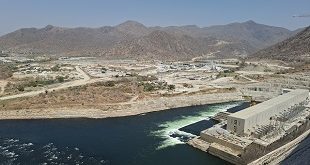
Unless the US can show that it’ll fight, Ukraine won’t escape from Russian influence to true independence
COMMENT | NANCY QIAN | The buildup of Russian forces near Ukraine’s border has led to fears of a new war. But the conflict is hardly new, and nor are Russia’s objectives. Ukraine, which has been indirectly controlled or directly repressed by Moscow-based governments for centuries, wants NATO to protect it from future Russian incursions, like the one the Kremlin launched in 2014. But Russian President Vladimir Putin is demanding that NATO promise not to expand into any more Eastern European countries that border Russia (which already shares a border with five NATO members).
NATO, led by the United States, is refusing Putin’s demand on the grounds that all countries have a right to decide their own fates. But protecting Ukraine’s independence is not as straightforward as it seems. There is an asymmetry between the cost that Russia is willing to pay to control Ukraine and the cost that NATO countries are willing to pay to protect it from Russian suzerainty.
Russia has few allies, whereas NATO comprises 30 of the world’s richest countries, many of which have modernised militaries. Nonetheless, over the past 200 years, Russia has managed – almost always through force and aggression – to use small neighboring countries as a buffer against Western European countries that might threaten it.
Putin views today’s geopolitical landscape in much the same way. He worries that, since the collapse of the Soviet Union, Russia’s western buffer has been reduced to Belarus. Keeping Ukraine within the Kremlin’s sphere of influence is thus critical for his strategy of ensuring Russia’s national security and boosting its geopolitical standing.
Most NATO members, including the U.S., almost certainly do not have the same level of motivation as Putin does. Moreover, history has shown how difficult it is to secure the independence of states with large belligerent neighbours. During the Cold War, the U.S. fought a costly war to preserve South Korean independence. It then fought an even costlier war to keep South Vietnam independent, and failed. All told, those two wars in Asia lasted 20 years and cost around $1.2 trillion, resulting in more than 90,000 U.S. military deaths.
The U.S. has recently relearned some of the lessons from those earlier wars. Last year, it withdrew from Afghanistan after 20 years of failing to establish political order or a functioning national economy. Before Western personnel had even left the country, it had already been retaken by the Taliban. And although Afghanistan is very different from Ukraine, the fact is that the American public has little appetite for another foreign military campaign.
These facts are well known to Putin, an authoritarian leader who is not constrained by domestic public opinion in the way that his Western counterparts are. Whereas the U.S. and its allies will have a hard time convincing constituents that a war to defend Ukraine is worthwhile, Putin can capitalize on the fact that Russian nationalism has been rising steadily in recent years. Putin’s approval ratings soared after Russia’s annexation of Crimea in 2014.
True, Putin’s approval has declined significantly since then, and the Russian public appears to be wary of war in Ukraine. But Putin knows from historical episodes, such as the Soviet Great Famine, that it is possible to impose significant costs on the Russian population to achieve major political objectives.
Moreover, NATO’s own behavior may have strengthened Putin’s resolve to pursue a strategy of aggression. When Russian GDP and military spending were at all-time lows after the dissolution of the Soviet Union, NATO did not disband, even though it had been established for the explicit purpose of Cold War containment of the Soviet Union. Instead, it expanded to include the Soviet Union’s former satellites in Central and Eastern Europe – and even three ex-Soviet republics.
By 2008, Russian GDP and military spending had recovered, and France and Germany had begun to express reservations about provoking Russia by inviting Ukraine and Georgia to join NATO. This put them at odds with U.S. President George W. Bush’s administration, and it was agreed that NATO would issue a vague promise of future membership to Ukraine (the Bucharest Compromise).
A few months later, Russia invaded Georgia, and the West put up little resistance. Moreover, this strategic victory for Putin coincided with an economic boom, all of which helped to entrench his political power.
From Putin’s perspective, NATO is likely to absorb Ukraine sooner or later if it thinks that Russia will no longer fight to prevent it. But if Russia demonstrates credibly that it will fight for control of Ukraine, one of two things may happen: the West will negotiate for peace; or there will be a war that NATO will have little appetite to fight. Either way, credibly threatening a war maximises Putin’s chances of keeping Ukraine in Russia’s sphere of influence.
The U.S., historically the most outspoken proponent of NATO expansion, needs to assess the situation soberly. Russia will fight, and unless the U.S. can credibly show that it will fight, too, Ukraine will be unable to escape from Russian influence and be truly independent. In the worst scenario, the U.S. and the West, indecisive and half-hearted, end up in a war that they will ultimately abandon, with Ukrainians bearing the brunt of the human and economic costs.
While some in the West are showing signs of accepting today’s harsh realities, others argue that any willingness to reach an agreement with Putin would be equivalent to British Prime Minister Neville Chamberlain’s appeasement of Nazi Germany at Munich. This is incorrect. Preventing a war is the best thing that the U.S. and its allies can do to preserve Ukraine’s well-being, if not the ideal of full independence.
****
Nancy Qian, Professor of Managerial Economics and Decision Sciences at Northwestern University’s Kellogg School of Management, is Founding Director of China Econ Lab and Northwestern’s China Lab.
Copyright: Project Syndicate, 2022.
 The Independent Uganda: You get the Truth we Pay the Price
The Independent Uganda: You get the Truth we Pay the Price


